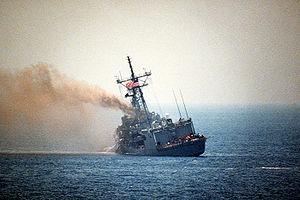25th Anniversary, Disaster in the Gulf; Remembering USS Stark's Valiant Family

The American flag flutters above the nearly cut in two and listing USS Stark (FFG-31). On May 17, 1987, in the Persian Gulf –15 months before the Iran/Iraq War ends – the guided missile frigate is on a routine exercise in international waters.
At one point, the Stark has under surveillance a distant French-built Iraqi Mirage F-1 fighter plane. As it flies closer, the guided missile frigate detects the aircraft’s radar and radios two messages asking for identification. No responses. The stage is set for the only successful anti-ship missile attack on a U.S. Navy warship.
The Iraqi pilot launches into USS Stark two deadly 1,500 pound French-constructed Exocet missiles, then veers away and skedaddles back to Iraq. Explosions and fires rock the ship. Out of the chaos comes Stark officers and enlisted hell bent on rescuing their ship at all costs.
Iraqi dictator, Saddam Hussein, quickly apologizes in a letter to President Reagan, which he accepts. Hussein explains that the pilot – who remains anonymous – mistook the Stark for an Iranian ship. Further, Iraq will correct the error with compensation to the victims’ families and, eventually, some millions toward a major rebuild of the severely damaged frigate. The money is no consolation to the families of the 37 off-duty, enlisted sailors who died as they slept in their racks. Hussein ignores compensating Stark’s 21 wounded, including two with brutal burns.
On these May 17-18 days, all Stark sailors are heroes. Although 25% of the crew has perished or is disabled, the remaining 115 or so officers and enlisted aren’t about to give up their ship. So for more than 18 hours, outside and within the ship, they battle raging fires and dangerous flooding. Credit goes to them for their damage control skills that save the USS Stark and, thus, the loss of more shipmates.
MORE TO COME


